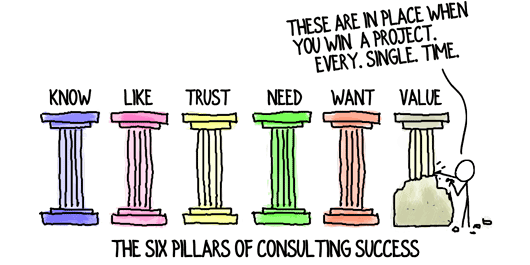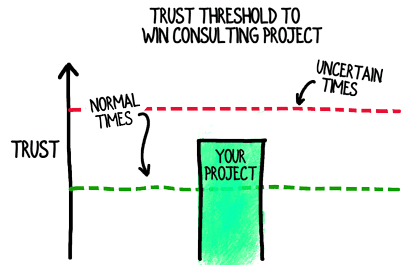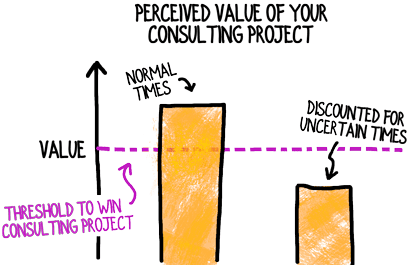Two Issues Your Consulting Firm Must Confront to Win Projects in Uncertain Times
Your consulting firm has probably encountered more resistance from prospective clients than usual over the past eight weeks. Fortunately, you can understand and overcome the elevated stumbling blocks.
The basics of winning consulting projects haven’t changed. Keep them moist and use lots of butter. No, wait. That’s for sheets of phyllo dough. To win consulting projects, your consulting firm still needs to outperform every alternative on The Six Pillars of Consulting Success.

However, the change and uncertainty that have swept the globe have also spawned two shifts in how prospects evaluate your consulting firm’s offerings.
Heightened Risk Sensitivity
Prospects are more sensitive to risk. Therefore, you must clear a higher Trust threshold to win consulting projects.
In particular, prospective clients are less certain you can help right now, and more concerned hiring your consulting firm will (inadvertently) cause harm. That’s not personal to your consulting firm—distrust is in the air.**

Extended Time Horizon
Prospects want to maximize their flexibility to take actions in the murky future. In order to preserve cash for unforeseen activities, prospects heavily discount the Value of your near-term consulting project.
You’re competing with future priorities as well as current needs, and that’s a larger, tougher competitive set than your consulting firm typically faces.

Take Action!
Equip your consulting firm to succeed by updating your messaging, your relationship-building conversations and your discovery process to confront both challenges.
Specifically, develop concrete, written answers to the following questions:
- Given that your consulting project will consume precious resources now, why does your offering not reduce your client’s flexibility to respond to future priorities?
- Better yet, how does your consulting firm’s offering improve your clients’ ability to quickly respond to future circumstances and exigencies?
- What additional reassurances can you provide that working with your consulting firm won’t inadvertently leave your client worse off?
- What new support points can you provide that bolster your claims? Social proof is particularly powerful right now (e.g., “In the past two weeks, we’ve started baklava consumption projects with a number of bakeries very similar to yours.”)
Have you noticed other shifts in clients’ buying criteria?
Text and images are © 2024 David A. Fields, all rights reserved.

 David A. Fields Consulting Group
David A. Fields Consulting Group 

Great article.
Another thing that can help: Faster project turnaround
Responsiveness and speed are two of your most powerful tools in consulting. Consulting projects are like Pizza: customers value fast delivery.
I appreciate you contributing that useful insight, Boaz.
Love the six pillars, David, and the reminder for how things apply today.
It’s always useful to return to the basics, Jim–perhaps most useful when your usual systems and approaches are under stress. Thanks for chiming in today!
Thank you David, excellent one.
All the more excellent thanks to input and feedback from readers like you, Raed!
Usually that framing of risk reduction is related to the completion of the project. Increase confidence that they will get what they need while reducing risk of payment for something they didn’t want.
I like the idea of moving the focal point of risk reduction further into the future. Reducing risk of being painted in a corner while increasing confidence of future flexibility.
Kenny, one of the real breakthroughs in my ability to win consulting projects was understanding the role of risk and fear in prospects’ decisions. Consulting is, fundamentally, a risk-transfer exercise. Many risks are swapped in the construction of a consulting contract.
Completing the project, success and costs are all common, easy-to-surface risks. There are others as well, including reputation, self-identity, growth/stagnation, brand equity and many more.
I’m very glad you highlighted that aspect of the discussion, Kenny.
Love the six pillars, David. I tend to think both in terms of the company perspective (e.g. Business results) and also the individual clients’—how can this project help the person or team who hired me improve something that matters to them (e.g. reputation, learning something new, different people to work with). So—if it goes well—there’s both risk shifting and joint creation. In a time like this, maybe it’s working with fee timing to just get started on the area where the specific client has intrinsic motivation (“I know we’ve talked about how you want to do X also in context of the project—maybe we use that to get started even now?”)
That’s a fabulous example, Sarah. Offering better payment terms reduces cashflow risk and, as you suggested, phasing your project can allow you to get into motion with a client and create value.
Excellent contributions, Sarah–w00t!